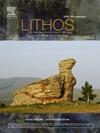冈瓦纳北缘早奥陶世岩浆活动中地壳岩浆的杂化与两个地幔源的直接证据
IF 2.5
2区 地球科学
Q2 GEOCHEMISTRY & GEOPHYSICS
引用次数: 0
摘要
在马尔毕卡-推杂岩中,花岗质片麻岩、花岗闪长岩和榴辉岩相片麻岩代表了高溶质花岗岩、花岗闪长岩和闪长岩的前亚碱性组合。过碱性片麻岩、含铁长辉石片麻岩和alaskitic片麻岩是由亚溶质碱长石花岗岩和石英碱长石正长岩的碱性组合而成。由开放体系作用形成的亚碱性组合:浅灰花岗岩类含有来自枯竭地幔源的岩浆、亚碱性基性包体[Y/Nb = 3-10];εNd(475) =−0.8 ~ +5.3]。此外,富氢硒花岗闪长岩与含铁闪长岩包裹体的存在表明其与从属碱性源杂交。在碱性组合中,过铝碱性长石花岗岩(alaskites)含有与亚碱性组合相同的基性包体,但也含有岩浆、碱性基性岩[Y/Nb = 0.5-1.1;εNd(475) = +1.3 ~ +3.6]。过碱性花岗岩、铝质碱-长石花岗岩和石英碱-长石正长岩是由碱性地幔熔体分晶演化而来,地壳同化作用较小。这两个火成岩组合发育于晚寒武世—早奥陶世大陆裂陷的区域背景下。在这种背景下,来自上升的地幔物质的热量和质量传递引起了地壳的深熔,由此产生的部分熔融与地幔衍生的亚碱性岩浆杂交,可能发生在晚寒武纪。随后,早奥陶世(481±1 Ma)亚碱性花岗岩类的形成也有少量碱性熔体参与。碱性熔体相对贡献的增加逐渐改变了酸性岩浆的组成,导致过铝碱性长石花岗岩的侵位,最终在472±1 Ma形成了幔源、过碱性和铝质花岗岩。本文章由计算机程序翻译,如有差异,请以英文原文为准。

Hybridization of crustal magmas and direct evidence for two mantle sources during Early-Ordovician magmatism at the NW Gondwana margin
In the Malpica-Tui Complex, granitic gneisses, metagranodiorite and eclogite-facies gneisses represent a former subalkaline association of hypersolvus granite, granodiorite and tonalite. Besides, peralkaline gneisses, ferropargasite-bearing gneisses and alaskitic gneisses derive from an alkaline association of subsolvus alkali-feldspar granites and quartz alkali-feldspar syenites. The subalkaline association formed by open-system processes: anatectic granitoids contain comagmatic, subalkaline basic enclaves from a depleted mantle source [Y/Nb = 3–10; εNd(475) = −0.8 to +5.3]. Also, the presence of HFSE-rich granodiorite with ferropargasite-bearing trondhjemite enclaves points to hybridization with a subordinate alkaline source. In the alkaline association, peraluminous alkali-feldspar granites (alaskites) contain the same basic enclaves as the subalkaline association, but also comagmatic, alkaline mafic rocks [Y/Nb = 0.5–1.1; εNd(475) = +1.3 to +3.6]. Peralkaline granite, metaluminous alkali-feldspar granite and quartz alkali-feldspar syenite evolved from alkaline mantle melts through fractional crystallisation, with minor crustal assimilation. The two igneous associations developed in a regional context of continental rifting in Late Cambrian - Early Ordovician. In this setting, heat and mass transfer from rising mantle materials induced crustal anatexis and hybridization of the resulting partial melts with mantle-derived subalkaline magmas, presumably in the Late Cambrian. Subsequently, minor amounts of alkaline melts were also involved in the generation of subalkaline granitoids in the Early Ordovician (481 ± 1 Ma). The increasing relative contribution of alkaline melts progressively changed the composition of the acid magmas, leading to the emplacement of peraluminous alkali-feldspar granites, and finally, of mantle-derived, peralkaline and metaluminous granitoids at 472 ± 1 Ma.
求助全文
通过发布文献求助,成功后即可免费获取论文全文。
去求助
来源期刊

Lithos
地学-地球化学与地球物理
CiteScore
6.80
自引率
11.40%
发文量
286
审稿时长
3.5 months
期刊介绍:
Lithos publishes original research papers on the petrology, geochemistry and petrogenesis of igneous and metamorphic rocks. Papers on mineralogy/mineral physics related to petrology and petrogenetic problems are also welcomed.
 求助内容:
求助内容: 应助结果提醒方式:
应助结果提醒方式:


